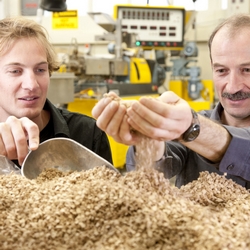Wood fibre dice takes on global plastics markets
 A breakthrough technology in fibre processing, combined with an exciting new business partnership, is creating global opportunities for using long wood fibres in plastic products.
A breakthrough technology in fibre processing, combined with an exciting new business partnership, is creating global opportunities for using long wood fibres in plastic products.In 2011, Scion negotiated a licensing agreement with Sonae Indústria Group for the manufacture and sale of wood fibre “dice” that has the potential to be much more revolutionary than its humble appearance suggests.
A major advantage of the wood fibre dice over agricultural fibres is that they do what dice do best. They roll, behaving just like plastic pellets, when fed into processing machinery.
This ease and accuracy of handling means the dice can be fed directly into conventional extruders, then the compound can go into injection moulders for processing as fibre-reinforced plastics.
Wood fibres typically have lower costs and more consistent supply than other fibres, and wood-fibre-reinforced plastics are stronger, lighter and have a lower environmental footprint than conventional plastics.
Sonae Indústria’s Global Manager WoodForce Christophe Chambonnet sees the commercial decision by the multinational giant as an exciting prospect.
“I have no doubt that we are creating a new perspective on the use of renewable wood fibre,” he says. “Scion is clearly a leader in research involving sustainably-derived bioproducts. Together with our expertise, we make a unique and powerful team.”
Sonae Indústria is a leading global player in the wood industry, with 27 production sites in seven countries processing seven million tonnes of wood a year. The agreement with Scion gives them an exclusive licence to commercialise the technology in Europe and create whole new markets for sustainably-produced wood fibres.
Wood fibre dice add strength to traditional polymers via a highly consistent and cost- effective route. So much so, that Sonae Indústria launched the technology as ”WoodForce” in December, 2011. Commercial-scale manufacture of WoodForce is already at 5,000 tonnes per year.
The new product has attracted attention from several European and North American compounding companies which are trialling WoodForce. Subsequent injection moulding trials have resulted in good quality parts, sparking interest from further down the supply chain.
Scion materials scientist Damien Even has successfully trialled the use of WoodForce in industrial-scale plants in Europe. Knowledge gained from overseas commercial trials is extremely valuable as Scion seeks to use this technology more widely in New Zealand.
“Wood fibre is a superior option with clear advantages over agricultural or glass fibres, so we will be working hard to promote the benefits of this product,” Mr Chambonnet says.
“We welcome this as a significant opportunity to redefine our business and expand our horizons. We have reached an agreement with Scion to make WoodForce a unique global brand.”
While the first commercial applications of the technology are likely to appear in Europe, Sonae is planning to expand into North America, followed by Asia. Such moves will trigger new licensing agreements with Scion. The intellectual property is retained in New Zealand with Scion having filed international patent applications for the technology.
Scion Chief Executive Dr Warren Parker says the licence deal is likely to return significant royalties over the next decade.
“With commercial adoption of the technology in Europe, we believe there will be excellent opportunities for New Zealand manufacturers to enter new markets within our region, using established plant and equipment.” Dr Parker says.
June 2013
